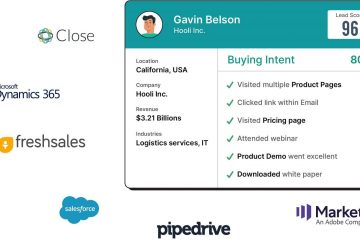B2B Lead Nurturing Campaign Examples and Strategies
Updated on 16th March, 2023.
Introduction
It is no secret that the B2B sales cycles are long. Marketing and sales teams must work together to navigate these long and complicated cycles successfully. But what if they’re not on the same page? Chaos ensues.
Enter lead nurturing, the magic sauce that can help you engage and convert customers. By implementing a robust lead nurturing strategy, you can attract and retain customers, building a long-term relationship that benefits both parties.
In this article, we will provide a complete overview of the B2B lead nurturing process, strategies, components, and examples that can help you improve your sales funnel in 2021.
What is Lead Nurturing?
When a lead first subscribed or signed up, they could have joined in several ways and for a wide range of reasons.
Some will have an interest in you because they are actively looking for your product and want to buy something from you. This is an ideal situation for marketing and sales teams as their jobs become a lot easier than usual. However, if you are generating a lot of top-of-the-funnel (TOFU) leads, you would not have this ideal situation most of the time. This means that those leads are just looking for information and probably aren’t ready to buy yet, and any attempt to sell to them is unlikely to be productive.
Also, if your product solves a variety of problems, your leads will have different and personalized requirements. In that case, you need to convey the correct message to them and engage them before they are ready to buy.
Lead nurturing refers to the process of engaging and developing relationships with potential buyers at different intervals of a sales funnel. The most sophisticated and reliable lead nurturing campaigns rely on effective communication and marketing efforts.
Of course, the more you understand the needs of your prospects, the better you can offer the information they need. Interact with them to help them get to know you and your product better. Show them that they can trust you and that you have something that can help solve their problems. Keep on doing this until they are ready, and then move in for the close.
How Important Is Lead Nurturing For B2B Companies and Why Should You Use It?
Improving your chances of getting a sale is obviously a good thing for any business, but just how effective is it and why should you use it yourself?
For starters, around 96% of people who visit your website are not ready to buy at first. At first glance, this might look like a negative statistic but, if you play your cards right, there is a lot of potential to tap into. Even though around 96 in every 100 are not ready to buy yet, they have still chosen to click on a link to your website. This means they have some degree of interest in what you are selling, provided the traffic source is genuine.
Marketers today use different lead nurturing strategies and lead scoring systems to nurture relationships with prospective buyers. Segmenting your leads based on their profile and requirements can help you serve more targeted content and create more meaningful relationships. For example, Salespanel can help you trigger automated drip campaigns based on the profile and behavior of your leads. But more on that later.
Lead generation is a perfect-segmented process that brings you closer to your targeted customers. You can, of course, count on expected sales without a lead generation strategy. You need to think of B2B lead generation as an effective way to increase your chances to reach out to your intended customers in a short time.
You can continue to nurture your leads even after they sign up and the longer you can attain the customers, the more loyalty you can expect. Your customers will also learn how to better use your product. Besides, analyzing your lead nurturing campaigns can help you understand different behavioral patterns of your customers.
With a creative lead nurturing strategy, you can transform your entire customer acquisition plan and make it more responsive than ever. Lead nurturing has the power to improve your ROI and simplify your sales cycle.
Some More Stats That Prove the Needelevance of B2B Lead Nurturing
- The ad spending on lead generation is expected to surpass $200 billion by the end of 2023.
- 70% of firms concur that their lead generation budget continues to increase, whereas 34% agree that they will see another spike in the coming years. The more TOFU leads you generate, the more need you have for nurturing.
- Segmented email campaigns can increase revenue by at least 760%.
- The total annual spending on marketing automation by companies is expected to reach $25.1 billion by the end of 2023.
- The companies that do excel at nurturing generate around 50% more sales-ready leads than companies that don’t, and at 33% lower costs.
- Not only does this mean more deals, but lead nurturing can also mean larger deals. Indeed, one study shows that nurtured leads make purchases that are 47% larger on average than non-nurtured leads.
What Does it Take to Create a Perfect Lead Nurturing Plan?
It is not rocket science to plan, execute, and optimize a lead nurturing plan. But, it takes a certain degree of constant monitoring and A/B testing to create a proper framework that would convert the prospects into returning customers.
Phase 1: Define and categorize your leads
The first part is to define your audience based on customer profiles. With different customer profiles at hand, your marketing team will be able to tailor offers in a way that makes them more appealing and serve highly targeted content.
Also, in a B2B scenario, it is important to understand the Firmographic differentiators of your leads. This includes factors like which industry a business is in, where they are located, how well the company is performing, their revenue and profits, and how they do business.
The content you send to small business leads can’t be the same as the content you send to Fortune 500 companies. They simply have different requirements. Create buyer personas based on profile attributes.
Phase 2: Segment and Score your leads
Now that you have identified buyer personas, it is time to break them down into data points and segment them accordingly. You can segment based on industry or company size for example. You don’t necessarily have to create a complex framework with complex customer profile variables. Instead, focus on a balanced segmenting and sub-segmenting approach that can help you understand the behavioral patterns of your customers. Your objective here is to increase the engagement and relevance of your lead nurturing campaigns.
Nurturing is also a dynamically changing process for every lead. If your average sales cycle lasts one and a half months, the way you nurture on the initial days won’t be the same way you nurture on final days. As leads progress through the buying process, the content you serve them needs to change. The best way to achieve this is through lead scoring.
Lead scoring is a system that enables you to ‘score’ your leads according to certain criteria. These criteria can include variables like age, location, income, and behavior such as which pages they have visited on your websites. The lead can be awarded (or deducted) points for multiple variables giving them a total score which helps determine how close they are to making a purchase.
Once scored, the leads can then be segregated into different categories, which are typically categories indicating how close the lead is to making a purchase. Leads in these categories can then be interacted with according to where they are in the sales cycle. For example, those that are still ‘cool’ may be invited to a webinar or given other marketing material. Those that have made it to the ‘hot’ category can be sent an offer. This system has been proven to be far more effective than using the same materials for all leads. Indeed, conversions are around 72% higher in leads that have been presented with the marketing materials that are relevant to where they are in the sales cycle.
Salespanel helps you in both segmentation and lead scoring and helps you automate targeted nurturing on any scale. More on that later!
Phase 3: Create your nurturing content
Based on the customer segments and deal stage points you created, set up your content and message and decide how you want them to be conveyed to your leads. You can send them drip emails like welcome drips or you can also run dynamic retargeting campaigns. For example, when a lead advances through the sales cycle, you can change the content you show them. We talk about it in detail in the next section.
Phase 4: Optimize your lead nurturing campaigns
Lead nurturing is a continuous process that requires monitoring, testing, and optimizing to ensure the effectiveness of the campaigns. With proper testing, you can review customer insights and nurture more leads by tracking and optimizing at different touchpoints.
In fact, testing can help you understand what kinds of messages and what time of day would be more suitable to present. Simultaneously, you should optimize your content mix, pathways, and frequency of your lead nurturing process.
Most Effective B2B Lead Nurturing Strategies
Generating leads is only half the battle. The true challenge is turning those leads into paying customers. An effective lead nurturing campaign requires a planned approach that addresses the specific needs of potential clients. Here are eleven of the most efficient B2B lead nurturing strategies to help you achieve your marketing goals:
1. Content Marketing
One of the most efficient ways to gain the attention of customers is through content marketing. You can share eBooks, whitepapers, webinars, blog posts, and support articles. You can also convey your message through emails. A robust content marketing strategy will help you nurture B2B leads efficiently without needing your sales team to intervene as frequently.
You can use an automation tool to share on different social media platforms and convey your message to prospects. You can repurpose your content in a sense of what your company currently has and then move on to expand the offering.
2. Marketing Automation
It is the use of software and technology to automate repetitive marketing processes and workflows. It is advantageous for B2B companies because it saves time, improves lead quality, and allows for personalization. For example, marketing automation software can help track leads and give them a score based on how they use a company’s website and content, and how interested they are in it. This lets businesses focus on the most qualified leads and tailor their marketing messages to their needs. Companies that employ marketing automation to nurture prospects saw a 451% increase in qualified lead volume.
3. Personalized Email Marketing
47% of marketers consider email marketing to be the best lead nurturing technique. But, personalization is crucial for email marketing. You may develop more relevant and exciting messages for each group by segmenting your email list based on characteristics such as job title, industry, or firm size. Personalized emails are proven to increase open rates, click-through rates, and conversion rates.
4. Drip Campaigns
They are automated email campaigns that are sent out to leads over time. According to a survey, nurturing leads through drip campaigns resulted in a 20% increment in sales for businesses. These campaigns are intended to gradually educate and persuade leads, bringing them closer to making a purchase decision. Each email in the drip campaign is tailored to the recipient’s needs and interests and delivers important resources that assist them in making a decision.
According to 68% of marketers, social media marketing has assisted them in generating more leads. Platforms like LinkedIn and Twitter can be effective tools for engaging with potential clients and promoting your brand. This involves sharing useful content, engaging with followers, and running targeted advertising campaigns. Having a strong social media presence helps in increasing brand awareness and more clicks on CTAs.
6. Retargeting Ads
Retargeting ads are used to target people who have already engaged with your brand at some level. You may boost the likelihood of them becoming clients by showing them ads personalized to their interests. Retargeting ads can be utilized on numerous platforms, such as Google Ads and social media platforms. Note – The average CTR of a retargeting ad is 10x that of a regular display ad.
7. Webinars
Conducting webinars is a very useful method for educating and engaging leads. You may establish trust and drive customers closer to a purchasing decision by providing relevant insights and answering their inquiries. Webinars can also help you convert MQls to SQLs. In fact, 38% of marketers agree that webinars offer higher quality lead generation than other channels.
8. Case Studies
A lead nurturing strategy that always works is case studies. Showcasing success stories enabled by your products or services can convince your target audience to click the CTA button. The needs and interests of your target audience should be the focus of your case studies. The case studies must show how your products or services can help your potential customers solve their problems.
9. Personalized landing pages
Personalized landing pages are tailored for specific campaigns or promotions. You can enhance engagement and conversion rates by curating specific landing pages for each level of the sales funnel. Customized landing pages are created to reflect the messaging and tone of the email or ad that directed the visitor to your page. This keeps the landing page relevant for the visitor. On top of that, a personalized CTA also works wonders. Personalized CTAs have a 202% better conversion rate than default versions.
10. Chatbots
They are AI-powered automation tools that provide customer support and deliver customized recommendations. You may improve the customer experience and boost conversion rates by including chatbots in your lead nurturing strategy. Chatbots can be deployed on your website, social media platforms, and messaging apps to provide support and guidance 24/7 (64% of consumers claim that the best feature of chatbots is their 24/7 availability).
Nurturing Automation with Salespanel
Salespanel can help you segment and score your leads to create your nurturing audiences and helps you trigger campaigns, both through emails and retargeting.
Based on these segments and lead score, Salespanel can connect with your favorite email marketing tool and push your audiences to relevant campaigns. It can also help you show highly targeted ads on social media and Adsense-enabled websites.
TL;DR: Salespanel works as a facilitator for your nurturing process on any scale.
Lead Nurturing Examples to Get You Started
We have cited several B2B and B2C examples as each serve a specific purpose and helps you independent of B2B or B2C targeting.
Groove’s Onboarding Campaign
Groove is a customer support and helpdesk software that helps businesses provide customer support at scale. Groove has over 8000+ customers and focuses on providing solutions to small businesses.
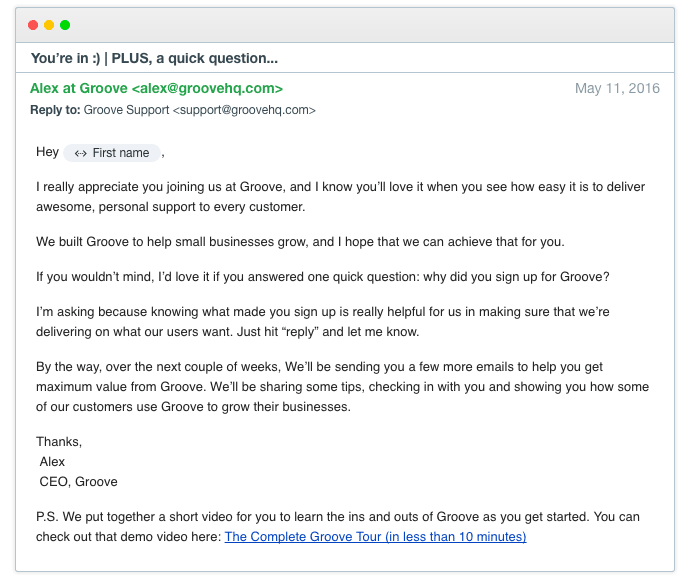
Groove’s onboarding campaign is by far one of the most popular welcome email sequences that has been an inspiration. Groove says that the email sequence has helped them turn trial customers into paid users. Notice how on their very first email, they mention that the recipient would be receiving a series of emails? This helps the recipient know what’s coming and react accordingly.
Evernote’s Welcome Email
Evernote platform offers hierarchical freedom to users to bookmark and save links. However, it uses a minimalistic and traditional approach when it comes to its sign-ups. Usually, users receive a dedicated email when they decide to sign up for Evernote.
This is their welcome email.
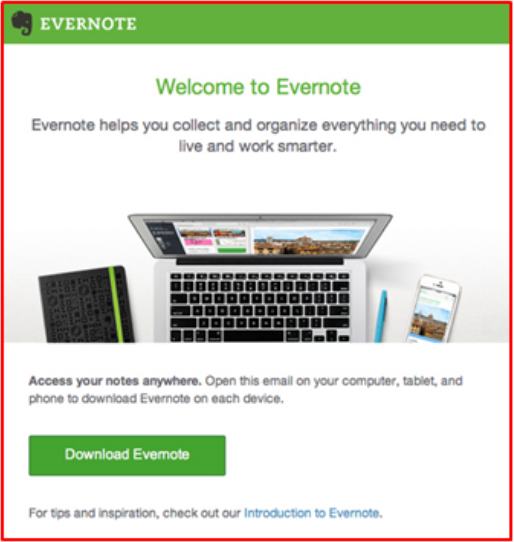
Source: https://www.superoffice.com/blog/b2b-email-marketing-examples/
It’s a win-win strategy that increases the conversion rate and user visits on the site. The email provides a dedicated link to download the software. Email tactic clearly works because it is what they have sent to their leads while acquiring over 200 million users for Evernote.
Headspace’s Survey
Headspace is another platform that prioritizes the use of emails to conduct surveys. The meditation app has managed to get millions of downloads and users in a short time. While this is a B2C example, you can understand how surveys can be helpful in nurturing your leads and getting more information about them. It helps you better tailor your content.
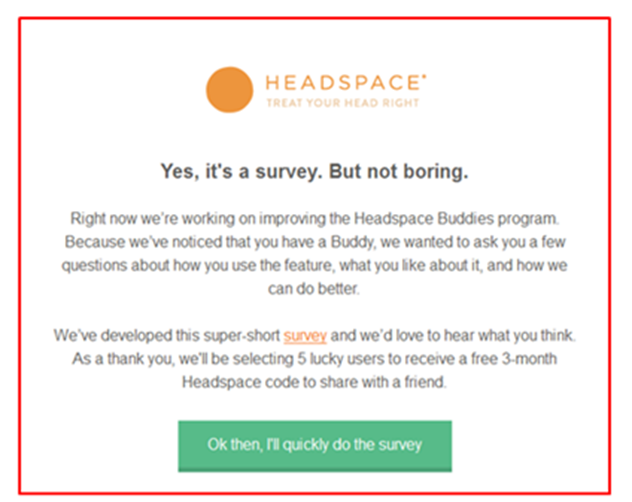
Source: https://www.superoffice.com/blog/b2b-email-marketing-examples/
What’s interesting is that Headspace doesn’t use traditional email surveys. Instead, it takes them to a hosted questionnaire that is straight to the point and engaging so that users will complete the survey. Furthermore, it uses a specific combination of color palette (i.e., black and green) throughout its email surveys to hold the attention of participants.
Drift’s welcome email
Welcome drip campaigns are meant to start a series of lead nurturing emails, keep the customer warm and engaged and at some point induce action from them.
Drift sent out one such powerful welcome email, which consisted of a few strategic pieces of content. A simple text message with no links or banners, welcoming them to the team and assuring them of not sending long boring emails.

Source: https://moosend.com/blog/drip-campaign-examples/
The email consists a list of the popular reads on their website, with links and icons showing the number of views for each read. With these, the company was able to earn the trust of their customers and also induce action by urging them to read their blog posts.
5. Netflix’s re-subscription campaign
Netflix, the hugely popular entertainment platform, sees a churn rate of around 2-3% with many customers leaving. Customers churn, for multiple reasons, including loss of interest or finding a better product, or just loss of engagement. In such cases, a re-engagement or win-back campaign is the best way to go, and that is exactly what Netflix did.
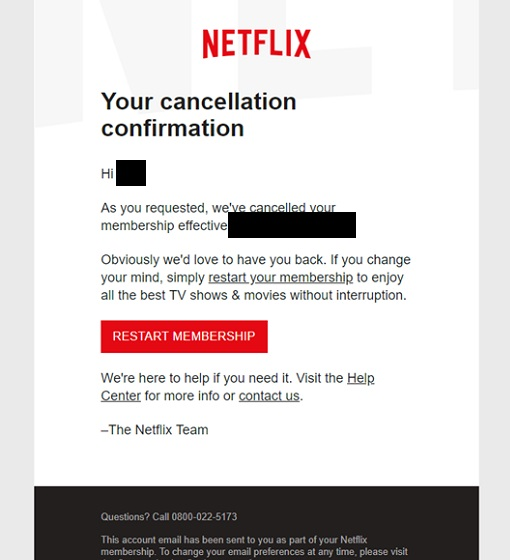
Netflix continued to send more emails and a list of shows to win the customer back. This is an effective way to nurture a churning customer.
Conclusion
Lead nurturing is not a one-time implementation for businesses. Instead, it requires a series of experimentation to capture leads and nurture them in an effective manner. Continuous analysis of metrics and A/B tests can help you obtain great outcomes.
The best course of action for you would be to adopt and embrace a systematic approach. Don’t hesitate to break the ice and build a personalized experience for prospects. Just focus on providing the most valuable, useful, and updated information. It is an effective way to form solid relationships based on trust and commitment.
Sell more, understand your customers’ journey for free!
Sales and Marketing teams spend millions of dollars to bring visitors to your website. But do you track your customer’s journey? Do you know who buys and why?
Around 8% of your website traffic will sign up on your lead forms. What happens to the other 92% of your traffic? Can you identify your visiting accounts? Can you engage and retarget your qualified visitors even if they are not identified?
